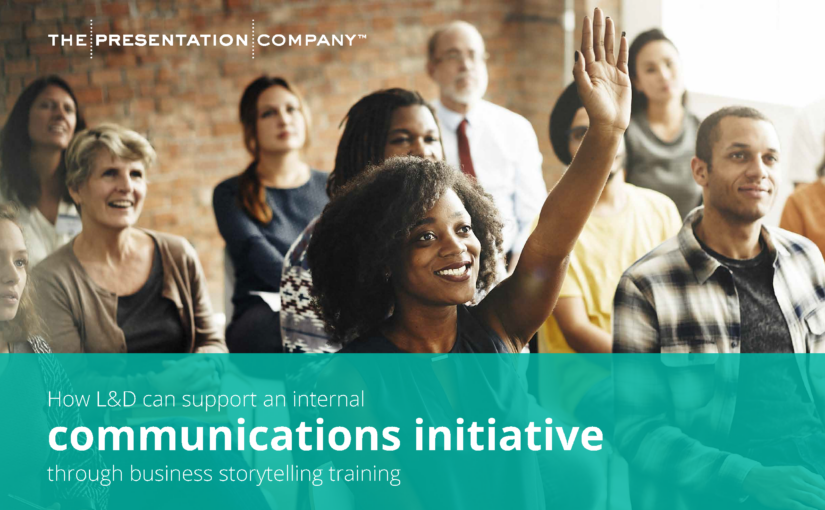Leadership development programs do exactly that: They develop leaders. But how they do that is the tricky part. What separates the best from the rest? That’s what you’ll learn in this article.
To sum up where we’re going, developing leaders is a bet on the future. The program provides the structure to bring your future vision into today. Said another way, leadership development programs propel your current high-potential people into your envisioned future.
Doing this well requires anticipating the organization’s needs in the future, taking stock of your present team, and charting a course from today to tomorrow.
 Anticipate the future
Anticipate the future
The first analysis L&D leaders need to do to create a topnotch leadership development program is to evaluate where the business is going. That way, you can plan backward and then work toward developing the skills your leaders will need to succeed in that future.
This analysis requires leaders to get a sense of the economic landscape and future projections, review career paths for internal candidates based on their skills and the external economics, and then prepare the talent pipeline to meet the internal skills with external needs.
To be sure, some of this might be a little heady. It also goes beyond just enterprise resource planning (ERP) software, though that can help in the analysis. That’s why L&D teams building a leadership development program need to consult with the rest of the talent management team, business leaders, and even financial and data analysis teams.
But let’s start with first things first.
How can you survey the economic landscape?
Consider the current, so-called Great Resignation. Millions of workers are leaving the workforce retiring early, dropping out, or taking time off to reassess their values. Millions more are reshuffling their career priorities and decisions about where they want to live and raise their families. This has all shaken up employers’ talent pipelines. You’re well aware of these trends.
Looking ahead, analysts at Emsi BurningGlass have labeled the next period the “Demographic Drought” because of larger structural issues facing the economy and American society in general like lower birth rates and higher rates of retirement, for example. This has led others to emphasize how the war for talent is back, “with an intensity unsee in recent years.”
Better understanding the future economic landscape including even macroeconomic and demographic factors like retirement rates can help influence how you build your program today.
For example, savvy leaders, like those writing this article in Harvard Business Review, know that they need to manage their talent pipeline like they would a supply chain. This includes drawing from a larger talent base, growing their own, and implementing fundamental principles from supply chain management. We cover these factors in more detail over the rest of this article. “Demographic Drought” “with an intensity unseen in recent years.”
Why should you start with a review of internal growth plans?
First, you’ll want to define what your organization s growth prospects look like. In which areas will you grow? Are certain skills required over others? Do you have the talent to fill those future-ready roles? Are they caught up in the Great Resignation? These questions are essential before building a leadership development plan.
The HBR article mentioned above says that only 31% of workers with expertise in emerging technologies today … were promoted from within. This may be because of a lack of technical skills within organizations. But it also may be because many L&D leaders haven’t adequately prepared their current workforces for the skills required for what’s next. Of course, that may be because those L&D leaders haven’t had the resources to do so, but we digress …
At the end of the day, it’s important to understand exactly who in your organization needs what skills. These are the fundamental questions facing every L&D professional: What skills do they currently have, what do they need in the future, and how can they get there?
Recent surveys mentioned in The Wall Street Journal noted how high turnover rates are being seen not only in low-wage, front-line jobs but also in middle-management positions, especially those held by women. This corroborates other recent data from McKinsey and LeanIn.org.
These studies all indicate that women need help balancing childcare responsibilities as well as gaining access to new leadership opportunities and learning new skills that will outpace the advances made by automation technologies. It’s a tall order. Yet there’s one skill that every position in the organization needs. (More details on that later.)
A review of your internal candidates and the skills they have will require the help of your ERP software as well as other talent management leaders to gain the insights required.
How can you prepare the talent pipeline?
Now, seeing the future and taking stock of the current talent needs, you can begin to build out your leadership pipeline. An article in Chief Learning Officer notes that today’s bench strength the quality of current leadership talent is at its lowest level in years. Leadership pipelines are running dry. The writer argues that senior leadership needs to address burnout, engagement, and strategic alignment if they’re going to create future leader success.
But how?
Eva Sage-Gavin, a former Fortune 500 CHRO, writes in HR Executive that leaders should first invest in continuous learning. Developing skills no matter the subject requires an ongoing, almost daily process of practice and refinement. It’s not a one-and-done approach.
After this process, you can take stock of the present to see what you need to do.
 Take stock of the present
Take stock of the present
You can’t get where you’re going without knowing where you are right now.
How can you assess your leadership bench, especially potential retirements?
According to the Global Leadership Forecast 2021 by DDI, a global leadership consulting firm, leadership bench strength is 10% to 25% below current capabilities in every industry surveyed. This means that as the economy grows again, companies will struggle to have ready-now leaders.
The reasons are varied, but here are a few common factors to be aware of:
- In the U.S. alone, 10,000 baby boomers turn 65 every day. According to an article by Arlene S. Hirsch for SHRM, this trend started in 2011 and will continue until 2030.Because the average retirement age for baby boomers (born between 1946 and 1964) lies somewhere between 61 and 65, it’s pretty clear that this so-called silver tsunami is going to create some serious challenges for L&D and HR learners.
- Among the varied reasons for an aging workforce, here are four common factors noted by Jeffrey Tamburo, an author and professor of labor relations and employment at Cornell University, in an article by the Academy to Innovate HR:
- Financial need: A lack of a proper pension plan or retirement savings forces a lot of people over 55 to continue to work. The fallout of the financial crisis of 2008 left many of them with debts and/or insufficient income from their pension.
- People are living longer and are healthier: The life expectancy for both men and women in the developed world generally increases.
- Talent shortages: The generation that came immediately after the baby boomers those born between 1965 and 1976 is a lot smaller. As a result, there aren’t enough people to take over the jobs of retiring baby boomers, who are being asked to stay
- Enjoying work and being productive: According to Tamburo, it seems that where millennials are looking for purpose in their jobs, baby boomers want to feel productive.
- Millions of women have dropped out of the job market altogether. One in three women say they have considered downshifting their careers or leaving the workforce in 2021, compared with one in four who said this a few months into the pandemic. Additionally, the report by McKinsey and LeanIn.org says their companies are switching jobs and high employee turnover in recent months suggests that many of them are following through.”
What’s your pipeline looking like? How are the trends outlined above likely to affect leadership gaps for your organization?
Why should you throw a wider net to identify high potentials?
As the DDI report says, Companies have six generations of employees at work, ranging in age from people in their late teens to vibrant workers in their 70s and 80s. So, the idea of a linear, progressive leadership pipeline must change.
Your future leaders could be older than you expect. Or they could be remote workers rather than people tethered to the traditional office space and who are more readily familiar to your leadership team. Or they could be from an underrepresented group that you didn’t initially imagine fitting this role.
As you reconsider where your organization looks for its future leaders and how you can increase leadership retention, consider these factors that a DDI analysis concluded are most predictive of a leader’s engagement and long-term retention. In order of the most impact, leaders who intend to stay:
- Know what constitutes good performance in their role
- Have a clear understanding of their future career path in the organization
- Feel that their direct manager genuinely cares about their well-being
- Have a high-quality development plan
- Receive effective coaching from their manager
- Get feedback on their skills
- Have access to the information and tools needed to do their job well
It’s important to note that what’s not on that list are such things as promotion rate, taking on new assignments, or work-life balance.
Why should we learn to develop talent virtually?
You may not agree, but the future of work will be largely in the cloud. That could mean fully remote work, a hybrid model of remote and office-based jobs, or even an altogether decentralized framework (a Decentralized Autonomous Organization, or DAO, with work rules embedded into a completely transparent code and not influenced by central leadership).
Regardless of the model, the writing on the wall says talent leaders now need to embrace the reality of virtual work and work toward integrating it into their current practices.
What are your strategies for developing talent virtually? How many employees do you expect to hire that are remote or hybrid? How do your current employees feel about this kind of future?
Researchers at MIT’s Sloan School of Business suggest taking five critical steps to start developing early career talent in a virtual workplace:
- Set up new employees properly. Ensure everyone has the technology they need and the training to use it. MIT Sloan research found that when interns and early career hires can rely on their remote work setups, it becomes 85% easier for them to connect with peers and to reach out for help when needed.
- Connect interns and early career hires with mentors. Explicitly pairing each new hire with a mentor ensures that this traditionally office-based opportunity for growth and connection doesn’t go missing in a completely virtual workplace. MIT Sloan’s study concluded that access to a mentor reduces stress from a daunting workload by over 70%.
- Run frequent virtual events, workshops, and training programs. Learning opportunities tend to fall by the wayside when people are working remotely. The most effective virtual training exercises that MIT Sloan observed helped more than 75% of entry hires understand and adopt their company culture.
- Use the opportunities that remote work provides. With virtual meetings and collaboration now the norm, it’s possible for interns and new hires to work with a broader range of colleagues. Rotating through different departments improves early career employees’ confidence by 80% and it helps them figure out what they’re most interested in, MIT Sloan research found.
- Ensure that new hires feel confident in their roles and have a grasp on the opportunities in front of them. MIT Sloan research suggests this can be achieved by granting employees more autonomy than ever by reducing and reassigning responsibilities that they find draining and disengaging letting workers design their own job descriptions and make modifications that suit them specifically to better reflect their strengths, interests, and core values.
 Chart a course from the present to the future
Chart a course from the present to the future
Now that you have answers to help better know where you’re starting from and where you’re headed, you can create a plan of action to move down that path. Here are three questions to ask before you start.
Why do I need leadership buy in across departments?
If your executive sponsors aren’t on board, the whole program may come apart before it even gets going. It’s crucial that you get executive buy-in for what each department needs of its future leaders.
Why should I seek to include many different learning styles?
Learners today need a variety of modalities to learn effectively, including video, audio, in-person, virtual, on-demand, and so on. Be inclusive of the types of learning your program incorporates and the needs of every employee.
Why should I include training for communication skills?
Many leadership development programs focus on technical skills for specific roles: finance, supply chain, and logistics even HR for people management executive seats. However, the best programs focus on transferable skills like communication. This is among the most important skills for future leaders, since much of what they’ll be doing is transmitting information between departments as well as between technical roles and senior leadership.
 Assess the present to impact the future
Assess the present to impact the future
We hope that these questions and resources will help you guide your leadership development program into an uncertain future, one that will encourage and equip your people to help your business succeed.


